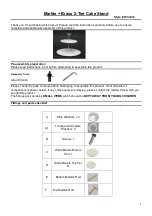
14
Settings table and tips
Tips for cooking and roasting
The values in the settings table serve as mere
guidelines, since more or less heat may be required,
depending on the type and condition of the foods, as
well as the size and fullness of the pot.
The high output causes grease and oil to heat up
quickly. Don't leave food unattended while frying;
grease can catch fire and burn the food.
Wok tips
We recommend woks with a concave bottom. You can
order a high-quality wok as a special accessory (WP
400 001)
For cooking, only use cooking oil that can be heated
up, such as peanut oil, with the wok.
Cook the ingredients at high heat while stirring
constantly, for not too long. The vegetables should
still be firm to the bite.
It is advisable to use a flat ladle with a long handle,
made of heat-resistant material, to stir and scoop out.
Information on cookware
The following information will help you save energy
and avoid damage to cooking vessels.
Appropriate cooking vessels
Pots with a diameter of less than 160 mm or greater
than 320 mm shouldn't be used.
If you use larger pots,
they must not protrude beyond the width of the
appliance.
Information for use
Setting range
Cooking proce-
dure
Examples
Full flame
‘
Bring to the boil Water
Frying
Meat
Heating up
Grease, fluid
Bring to the boil Soups, sauces
Blanching
Vegetables
From
‘
to
’
Roasting
Meat, fish, potatoes
Baking
Pastries, egg dishes
Simmering
Dumplings, boiled
sausage, boiled meat
Whipping
Creams, sauces
Boiling
Soups, potatoes
Steaming
Vegetables, fish
Stewing
Vegetables, fruit, fish
Braising
Goulash, roasts, vege-
tables
Low flame
’
Thawing
Frozen foods
Soaking
Rice, pulses
Warming up
Soups, stews, vegeta-
bles in sauce
Burner
Recommended
diameter of pot
base
Minimum diame-
ter of pot base
Wok burner
240 - 320 mm
160 mm
Use cooking vessels of
appropriate size for the
particular burner.
Don't use small cooking
vessels on large burners.
The flame shouldn't come
in contact with the sides of
the cooking vessel.
Don't use any deformed
cooking vessels that don't
stand solidly on the
cooktop. The vessels could
tip over.
Only use cooking vessels
with flat and thick bottoms.
Don't cook without a lid or
if the lid is not on all the
way. The majority of the
heat is lost.
Place the cooking vessel in
the center of the burner,
otherwise it may tip over.
Don't place large pots on
the burners near the stove
controls. They could
overheat and become
damaged.
Summary of Contents for VG 414 210 CA
Page 1: ......
Page 2: ......
Page 3: ......
Page 4: ......
Page 5: ......
Page 6: ......
Page 7: ......
Page 8: ......
Page 9: ......
Page 10: ......
Page 11: ......
Page 12: ......
Page 13: ......
Page 14: ......
Page 15: ......
Page 16: ......
Page 17: ......
Page 18: ......
Page 19: ......
Page 20: ......
Page 21: ......
Page 22: ......
Page 23: ......
Page 24: ......
Page 25: ......
Page 26: ......
Page 27: ......
Page 28: ......
Page 29: ......
Page 30: ......
Page 31: ......
Page 32: ......
Page 33: ......
Page 34: ......
Page 35: ......
Page 36: ......
Page 37: ......
Page 38: ......
Page 39: ......
Page 40: ......
Page 41: ......
Page 42: ......
Page 43: ......
Page 44: ......
Page 45: ......
Page 46: ......
Page 47: ......
Page 48: ......
Page 49: ......
Page 50: ......
Page 51: ......
Page 52: ......















































